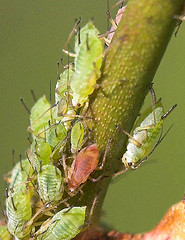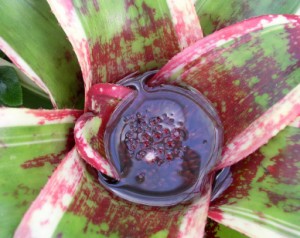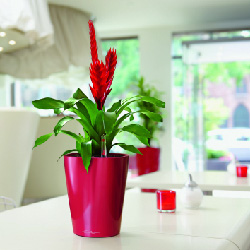7 Common Bromeliad Care Mistakes
Author: Celeste Booth38 Comments
Bromeliads are easy to care for, which makes them ideal indoor plants especially to new growers. If you are just starting out and want a plant that is easy to maintain, most bromeliads will thrive with little maintenance. However, the following are a few common mistakes that should be avoided when caring for your bromeliad.
1. Overwatering
The most common mistake is overwatering. It is often assumed that because bromeliads are tropical they need a lot of water all of the time. It is true that many bromeliads like humidity, but they do not like their feet wet. Most bromeliad’s roots act more like an anchor than the main source for taking up water and nutrients. Therefore, if the soil remains constantly wet, the roots will likely rot ultimately killing the plant. To avoid this problem, allow the potting medium to dry before further watering. Even if it appears dry on top, it may be retaining water further under the surface. Stick you finger a few inches into the pot and check to make sure the potting medium feels dry at that level. If you are unsure, it is best to wait another day and check again. Most bromeliads can tolerate drought. They will not thrive and grow in consistent drought, but they are less likely to die of drought than rotting.
2. Choosing the wrong container
As mentioned above, most bromeliads’ roots act as anchors and do not grow very large. A small pot between four and six inches will be large enough to hold most bromeliads. Using a container that is too large for a bromeliad will result in the potting medium retaining too much water and the bromeliad suffering the same consequences as overwatering; the roots are likely to rot eventually causing the plant to die.
3. Using the wrong potting medium
Never use garden dirt or top soil in a pot meant for bromeliads. Soil from the ground will be too dense and retain too much water. It may also carry disease, fungus and pests that will damage a bromeliad. Instead use a potting medium that is specially formulated for growing bromeliads. There are many soil-less mixtures on the market that are designed to allow quick drainage. These bromeliad potting mixes can be found at garden centers and nurseries.
4. Exposing your plant to copper
Bromeliads are very sensitive to copper and exposure can cause damage and even the death of the plant. It may seem unlikely that a plant will be exposed to copper, but there are a few instances when it is possible if the grower is unaware of the presence of copper. The two most likely accidental exposures occur when mounting an epiphytic bromeliad.
- Do not use copper wire when mounting a bromeliad. Water resistant glue is a good alternative to wire for mounting.
- Avoid using treated wood when choosing a mount for a bromeliad. It is usually pressure treated with copper to make it more weather resistant.
- Copper can also be found in some fungicides. If you are using a fungicide make sure it is specified for use on bromeliads.
5. Assuming all bromeliads are the same
There 57 different genera of bromeliads. Within those 57 genera are over 3,000 different species and many more cultivars. While many bromeliads are similar, some have unique adaptations that they have developed to survive in their native habitat. Cryptanthus, for example, like to stay moist while most other bromeliads like to dry out a bit between waterings.
All bromeliads originate from warm climates. Some are adapted to thrive in arid regions while other are adapted for growth in humid regions. Some bromeliads grow naturally on forest floors, while others grow clinging to trees and other host surfaces. Make sure you know what kind of bromeliad you have and how to best care for it. There are a few questions you should ask the grower before you buy a bromeliad: Should it be mounted or grown in potted? Does it like humidity or dry climates? How much light does it need? How big will the plant get? It is important to make sure you can properly care for that specific type of bromeliad before you invest in the plant.
6. Exposure to an infested plant

-Aphids
Bromeliads have few pest problems especially when grown in the home. They are so far away from their original habitat that natural predators don’t pose much threat. However bromeliads can be susceptible to mealybugs, aphids and scale. If the infestation happens in your home it is most likely because a previously infested plant was introduced into the environment. Any time you purchase a new plant you should keep it quarantined from other plants for three weeks. Even if no traces of the pests exist when you bring home the plant, eggs that are invisible to the naked eye could hatch and spread pests to the other plants in your collection. During this three week time watch closely for insect infestations. If the plant remains pest free at the end of the trial period, you can safely place it with your plant collection without fear of introducing new pests.
7. Hard Water

-Central tank
Hard water can leave deposits both on the leaves near the base of the plant and in its central tank. These deposits can damage the leaves and make them more susceptible to disease. Water in the tank should be regularly flushed to avoid the build up of salts. As an alternative to tap water, you can use rain water or distilled water. This will prevent the build up of any minerals and is preferred.
Bromeliad care is fairly straightforward. If you are a beginner, do not be intimidated by these potential mistakes. Most bromeliads are very resilient. If they are showing signs of problems, they can be easily salvaged with a little troubleshooting. Be vigilant and at the first sign of a problem begin seeking out a solution The earlier a mistake is discovered and corrected, the easier it is for the bromeliad to recover and remain a beautiful plant to display.
Sources
“Bromeliad Society International” <http://www.bsi.org/brom_info/FAQ.html>
“Bromeliaceae” Wikipedia <http://en.wikipedia.org/wiki/Bromeliaceae>
Johnson, Carol. “Cultural Hints for Bromeliad Growers.” Florida Council of Bromeliad Growers. <http://fcbs.org/index1.html>
Aphids photo credit: Fred Dawson via http://www.flickr.com/photos/fwp-dawson/424053223/
38 Responses to “7 Common Bromeliad Care Mistakes”
Leave a Reply

Resource Download
Hechtia Care Cheat Sheet
Learn how to care for your Hechtia bromeliad with this quick and easy informational guide.
Learn More
Ask an Expert
Questions about bromeliads?
Our experts love a challenge!
Photo of the Week
Submit your photo to be featured on the blog!
More Photo of the Week Winners
Submit Photo









When I first bought my bromeliade there was a lovely flower on top which was red. Now that red color has disappeared and the top of the plant is green. What do I have to do to restore that red flower?
I just inherited a Pink Aechmea bromeliade (my best guess) and was told that it only blooms once every 3 years. If yours is similar to mine then my guess is that the plant will flower again in about 3 years. Hope that helps!
That was the bloom, it will put out pups. Cut off the pups and repot them. The pups will bloom in time.
That was the bloom, it will put out pups. Cut off the pups and repot them. The pups will bloom in time.
It’s ok! It’s meant to do that! The flower won’t stay forever and it’ll grow back soon!
Very helpful information!!
We have a lovely bromeliad for the office – red spike – that is now turning brown – what do you do when the spike turns brown? Will it eventually fall off and another one will grow? Am I giving it too much water? The tag that came with the plant from the store says ensure that the soil is damp and there should always be water between the leaves. this is somewhat contrary to what your website says – not to water the soil often at all – let it be dry as water is retained inches down. Any suggestions? Thanks. DH
I discovered the dying flower will NEVER come back although, here is a trick ~ without damage to the plant. Remove the dying bloom and add an inexpensive orchid silk flower(s) or fake (like) bloom. A fake bird of paradise flower cut to fit the the plant is a nice touch too until your plant produces new “pups”. After reading this you will feel like an exprt on these plants.
Bromeliads that produce attractive flowers are often purchased in bloom. The flower spikes are exotic and beautiful and usually stay attractive for an extended period of time. For most bromeliads the flowers don’t provide the primary show, but the colorful bracts or modified leaves that accompany the flowers add to the display.
It’s important to know that after blooming bromeliad plants will never grow or bloom again. They go into a gradual decline and eventually die. Before they do, however, they produce one to several offshoots from their base called “pups.”
These young plants can be separated from the original plant when they are about one-third its size. Usually, they simply can be pulled off or cut off with a knife or pruners at the point where the pup is attached to the mother plant. Pot the pup in a small container with the appropriate planting mix and provide it with somewhat less light while it forms a root system. Then move it into the recommended bright light.
As the young plant grows, repot it into larger containers until it is in about the same size pot in which you bought the original plant. Pups will, with good care, usually bloom about two years after being separated.
I received a bromiliad 2-3 months ago & keep it in my office. It has done well until appx 7-10 days ago. The red leaf center has turned very dark. The soil is dry & in the original pot/soil mxture. I do not see any signs of bugs. What could be causing this?
Yes my bromeliad was over watered by accident the flower has wilted and looks like it going to die. If it does will it grow a new flower. Please help.
They only blossom one time in the life cycle. Usually before the entire plant dies, which can take a few years “pups” will form which can be removed to start new plants. Always plant the small pups in a small pot. There is a great deal of information on the web about these plants.
I Bought my bromiliad in Naples, FL. It came back to MN and I had it outdoors starting the end of May. It seemed to be unhappy with the hot sun and some very unusual Hot, very windy, days. Finally now I’ve brought it back in by a 1/2 day sunny window. Cleaned off the leaves and cut off some of the bad ends etc. I think it got somewhat scaled by it all. Seems to be recovering. Now it is sprouting another plant on the side of it. Should I somehow take it off and transplant to another pot and how should that be done?
Your bromelia is reproducing. This is the last stage of its life. Let the pup grow up to a 3rd of the main plant size then cut it off (separating the roots) and replant it.
I too have an office Bromliad. Yesterday I was at garden works so I asked about it. Apparently, they only flower once. The flower will last 2-3 months. Generally they are sold in bloom. After the flower is gone they will grow “pups” (new offshoots, like a baby) off the side of the plant. The pup can grow with the mother in the same pot and will eventually flower as well, or once the pup is 1/3 the size of the mother plant you can replant the pup in another pot of it’s own. It will then flower and the cycle continues. I’ve read varying things about if the mother plant dies or not.
My yellow bromeliad’s leaves are turning brown on the edges and curling under. Not sure if I overwatered or the couple of really hot days we had did it in. The red ones are okay. What have i done? Help
My bromeliad has a beautiful pink bloom in middle. The leaves about 4 days ago start curling n started getting yellow spots. I haven’t watered it fir about 2 weeks the soil was partly dry ..what am I doing wrong. It gets lots of indirect light
Addition to prior comment: the flower is turning brown at its edges; the actual leaves look like they are trying to curl inward.
Thanks for helpful info. I have been waiting another bloom & now I find out it won’t bloom again. So what I’ve been watching is a pup . Thanks. I’ll be separating them soon to see what happens
My bromeliad has become brown on the tips of the leaves. Its outside facing sun but in a pot on balcony. Whst am i doing wrong?
This is usually a good indicator that your bromeliad is too dry. Try giving it some more water.
I have light spots on my leaves. These are pups that I have planted. What am I doing wrong.
MY AECHMEA fasciata has a tiny pup on it… not really a pup yet.. its a bump really… but its been this way for a long time… it wont grow… still just a bump help!!!
I accidentally watered the soil directly -did I damage the plant?
No, your plant should be fine.
A friend thinned out her potted bromeliads and shared them with me (don’t know what kind but they’re common to Central Texas). I may have waited too long to pot them – I wasn’t able to pot them right away then I got sick for about three weeks. When I finally got around to them, they looked pretty dehydrated and dried up. I went ahead and potted them anyway. Should I expect them to revive or are they goners?
Should I grow my red/orange Bromeload in full sun?
My plants have all gone white is this from frost
I received my Bromeliad as an office gift after being out for surgery. That was 4 months ago. I am now seeing the brown come unto the leaves which were once red. I do have a Pup but it’s almost as tall as the original plant. Can I still separate it and will it bloom whenever it’s suppose to ? I am wondering if I waited to late to repot.
A friend thought the bromeliad looked so pretty and went to waste in the yard and -UGH- cut off the mother as it was in it’s beginning of the bloom. Can the mother plant still put out pups or is this plant a goner. We planted sveral pups iven to us by a neighbor about 5 years ago and this was the first bloom. Answer appreciated, thanks
Hi Kimberly, Not sure what you mean — what part was cut? The top from the roots?
My red-orange bromelia is prosucing little fine yellow shoots from the egde od blooms,with yellow powder coming from them. What is this and is a sign of its bloom end?
I am new to bromeliads, and I have recently bought a few for indoors. They are in my breakfast room that is surrounded in windows. I have a pretty big “strawberry parfait. It has broad leathery leaves. The bottom leaves have started curling. Them on one of my smaller ones (a pup), some of the leaves look bad…like they need to be pruned off. I don’t know what to do. I thought these were easy..lol. I planted them in a bark type potting mixture. Any help would be appreciated.
My is going browny black from tips of leaves down it looks bad like dieing what is wrong please i have it in my bathroom in the bath which is filtered light, i dont want to lose it was present from husband
Are you allowing it to dry out a bit between waterings? Bathrooms can often retain more humidity than other rooms due to showers etc.
I am also pretty new to the bromeliad world. About six months ago, I separated several pups from the main plant (which I threw away, having been told it will not bloom again) and am still waiting for them to flower. I was very excited when two of the four pups showed a red leaf, thinking the flower would come soon. Now, the red leaf is turning brown on both of the pups. Am I overwatering? Underwatering? Is this normal? Should I cut the brown/red leaf out? And, how long does it usually take for the pup to flower?
Most pups mature in 1-3 years. So if they aren’t yet looking like they might bloom, don’t lose hope! Has anything in their environment changed recently that would cause them be unhappy? Watering, temperature, air flow, etc?
i have a bromeliad pup. it has white spots on the base of its trunk. whats wrong with it
The leaves closest to the dirt are dying ..what do I do